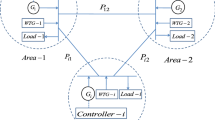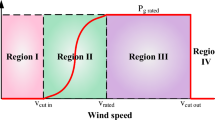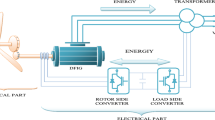Abstract
This paper investigates the combined effect of actuator saturation and time-delay on load frequency control (LFC) of a wind-integrated power system (WIPS). Actuator saturation is represented in two different approaches such as polytopic and sector bounding. Delay-discretization-based sliding mode \(H_{\infty }\) control approach is proposed to design a novel LFC scheme. The proposed control scheme requires present as well as delayed states information as input to the controller. This requirement of control scheme is fulfilled by adopting a finite known delay. This finite known delay used in controller design is discretized into delay intervals. Lyapunov–Krasovskii functional is defined for each delay interval, and \(H_{\infty }\) stabilization criteria for the closed loop WIPS are derived in linear matrix inequality framework using Wirtinger-based inequality. The proposed control scheme is tested by considering a numerical example of two-area WIPS.
















Similar content being viewed by others
References
Adhikari S, Karki R, Piya P (2019) Recovery risk mitigation of wind integrated bulk power system with flywheel energy storage. IEEE Trans Power Syst 34(5):3484–3493
Pradhan SK, Das DK (2020) A robust \({H_{\infty }}\) sliding mode control design for wind-integrated interconnected power system with time-delay and actuator saturation. Sustain Energy Grids Netw 23:100370
Luo J, Bu S, Chung C (2021) Design and comparison of auxiliary resonance controllers for mitigating modal resonance of power systems integrated with wind generation. IEEE Trans Power Syst 36(4):3372–3383
Mi Y, Hao X, Liu Y, Fu Y, Wang C, Wang P, Loh PC (2017) Sliding mode load frequency control for multi-area time-delay power system with wind power integration. IET Gen Trans Distrib 11(18):4644
Cui Y, Xu L, Fei M, Shen Y (2017) Observer based robust integral sliding mode load frequency control for wind power systems. Control Eng Pract 65:1–10
Prasad S, Purwar S, Kishor N (2019) Non-linear sliding mode control for frequency regulation with variable-speed wind turbine systems. Int J Electr Power Energy Syst 107:19
Guha D, Roy PK, Banerjee S (2021) Equilibrium optimizer-tuned cascade fractional-order 3DOF-PID controller in load frequency control of power system having renewable energy resource integrated. Int Trans Electr Energy Syst 31(1):e12702
Oshnoei S, Oshnoei A, Mosallanejad A, Haghjoo F (2021) Novel load frequency control scheme for an interconnected two-area power system including wind turbine generation and redox flow battery. Int J Electr Power Energy Syst 130:107033
Zhang CK, Jiang L, Wu Q, He Y, Wu M (2013) Delay-dependent robust load frequency control for time delay power systems. IEEE Trans Power Syst 28(3):2192
Jiao S, Xia J, Wang Z, Chen X, Wang J, Shen H (2021) An improved result on stability analysis of delayed load frequency control power systems. Int J Control Autom Syst 19(4):1633
Sun Y, Wang Y, Wei Z, Sun G, Wu X (2018) Robust \({H_{\infty }}\) load frequency control of multi-area power system with time delay: a sliding mode control approach. IEEE/CAA J Autom Sinica 5(2):610
Pradhan SK, Das DK (2021) \({H_{\infty }}\) performance-based sliding mode control approach for load frequency control of interconnected power system with time delay. Arab J Sci Eng 46(2):1369
Dey R, Ghosh S, Ray G, Rakshit A (2012) \({H_{\infty }}\) load frequency control of interconnected power systems with communication delays. Int J Electr Power Energy Syst 42(1):672
Zhao X, Sun Y, Li N, Wei Z, Sun G, Huang C (2016) Robust \({H_{\infty }}\) load frequency control of delayed multi-area power system with stochastic disturbances. Neurocomput 193:58–67
Pradhan SK, Das DK (2021) In 2021 international symposium of Asian control association on intelligent robotics and industrial automation (IRIA)
Qi W, Kao Y, Gao X, Wei Y (2018) Controller design for time-delay system with stochastic disturbance and actuator saturation via a new criterion. Appl Math Comput 320:535
Maddela CO, Subudhi B (2019) Robust wide-area TCSC controller for damping enhancement of inter-area oscillations in an interconnected power system with actuator saturation. Int J Electr Power Energy Syst 105:478
Pradhan SK, Das DK (2022) \({H_{\infty }}\) Controller design for frequency control of delayed power system with actuator saturation and wind source integration. Arab J Sci Eng 1–19
Yousri D, Babu TS, Fathy A (2020) Recent methodology based Harris Hawks optimizer for designing load frequency control incorporated in multi-interconnected renewable energy plants. Sustain Energy Grids Netw 22:100352
Dahab YA, Abubakr H, Mohamed TH (2020) Adaptive load frequency control of power systems using electro-search optimization supported by the balloon effect. IEEE Access 8:7408
Trip S, Cucuzzella M, De Persis C, Ferrara A, Scherpen JM (2020) Robust load frequency control of nonlinear power networks. Int J Control 93(2):346
Deng Z, Xu C (2022) Frequency regulation of power systems with a wind farm by sliding-mode-based design. IEEE/CAA J Autom Sinica 99(1):1–10
Sobhy MA, Abdelaziz AY, Hasanien HM, Ezzat M (2021) Marine predators algorithm for load frequency control of modern interconnected power systems including renewable energy sources and energy storage units. Ain Shams Eng J 12(4):3843–3857
Sathya M, Ansari MMT (2015) Load frequency control using Bat inspired algorithm based dual mode gain scheduling of PI controllers for interconnected power system. Int J Electr Power Energy Syst 64:365
Paliwal N, Srivastava L, Pandit M (2020) Application of grey wolf optimization algorithm for load frequency control in multi-source single area power system. Evolut Intell 15:1–22
Daneshfar F, Bevrani H (2012) Multiobjective design of load frequency control using genetic algorithms. Int J Electr Power Energy Syst 42(1):257
Sudha K, Santhi RV (2011) Robust decentralized load frequency control of interconnected power system with generation rate constraint using type-2 fuzzy approach. Int J Electr Power Energy Syst 33(3):699
Saikia LC, Mishra S, Sinha N, Nanda J (2011) Automatic generation control of a multi area hydrothermal system using reinforced learning neural network controller. Inte J Electr Power Energy Syst 33(4):1101
Bevrani H, Hiyama T (2008) Robust decentralised PI based LFC design for time delay power systems. Energy Convers Manage 49(2):193
Jiang L, Yao W, Wu Q, Wen J, Cheng S (2012) Delay-dependent stability for load frequency control with constant and time-varying delays. IEEE Trans Power Syst 27(2):932
Jin L, He Y, Zhang CK, Shangguan XC, Jiang L, Wu M (2021) Robust delay-dependent load frequency control of wind power system based on a novel reconstructed model. IEEE Trans Cybern 1–12
Prasad S, Purwar S, Kishor N (2016) H-infinity based non-linear sliding mode controller for frequency regulation in interconnected power systems with constant and time-varying delays. IET Gen Trans Distrib 10(11):2771
Pradhan SK, Das DK (2020) \({H_{\infty }}\) Load frequency control design based on delay discretization approach for interconnected power systems with time delay. J Modern Power Syst Clean Energy 9(6):1468–1477
Qian D, Tong S, Liu H, Liu X (2016) Load frequency control by neural-network-based integral sliding mode for nonlinear power systems with wind turbines. Neurocomputing 173:875
Wang C, Mi Y, Fu Y, Wang P (2016) Frequency control of an isolated micro-grid using double sliding mode controllers and disturbance observer. IEEE Trans Smart Grid 9(2):923
Mi Y, Fu Y, Li D, Wang C, Loh PC, Wang P (2016) The sliding mode load frequency control for hybrid power system based on disturbance observer. Int J Electr Power Energy Syst 74:446
Dahiya P, Sharma V, Naresh R (2017) Hybridized gravitational search algorithm tuned sliding mode controller design for load frequency control system with doubly fed induction generator wind turbine. Opt Control Appl Methods 38(6):993
Dev A, Sarkar MK, Asthana P, Narzary D (2019) Event-triggered adaptive integral higher-order sliding mode control for load frequency problems in multi-area power systems. Iran J Sci Technol Trans Electr Eng 43(1):137
Dahiya P, Sharma V, Naresh R (2019) Optimal sliding mode control for frequency regulation in deregulated power systems with DFIG-based wind turbine and TCSC-SMES. Neural Comput Appl 31(7):3039
Dev A, Sarkar MK (2019) Robust higher order observer based non-linear super twisting load frequency control for multi area power systems via sliding mode. Int J Control Autom Syst 17(7):1814
Fridman E (2006) Descriptor discretized \({L}yapunov\) functional method: analysis and design. IEEE Trans Autom Control 51:890
Han QL (2009) A discrete delay decomposition approach to stability of linear retarded and neutral system. Automatica 46:517
Kumar A, Pradhan SK, Das DK (2019) In 2019 international conference on electrical, electronics and computer engineering (UPCON). (IEEE), pp 1–6
Rahman A, Saikia LC, Sinha N (2017) Automatic generation control of an interconnected two-area hybrid thermal system considering dish-stirling solar thermal and wind turbine system. Renew Energy 105:41
Lee DJ, Wang L (2008) Small-signal stability analysis of an autonomous hybrid renewable energy power generation/energy storage system part I: time-domain simulations. IEEE Trans Energy Convers 23(1):311
Seuret A, Gouaisbaut F (2013) Wirtinger-based integral inequality: application to time-delay systems. Automatica 49(9):2860
Das DK, Ghosh S, Subudhi B (2014) Tolerable delay-margin improvement for systems with input-output delays using dynamic delayed feedback controllers. Appl Math Comput 230:57
Boyd S, El Ghaoui L, Feron E, Balakrishnan V (1994) Linear matrix inequalities in system and control theory, 15 (Siam)
Das DK, Ghosh S, Subudhi B (2015) An improved robust stability analysis for systems with two delays by extracting overlapping feature. J Control Decis 2(2):124
Das DK, Ghosh S, Subudhi B (2018) Delay-dependent robust stability analysis and stabilization of linear systems using a simple delay-discretization approach. IFAC-Papers OnLine 51(1):572
Funding
No external funding sources supported this research article.
Author information
Authors and Affiliations
Contributions
SKP was involved in Conceptualization, Methodology, Writing original draft. DKD contributed to Supervision, Review and Editing.
Corresponding author
Ethics declarations
Conflict of interest
The authors declare that they have no conflict of interest.
Consent to participate
For this research article, the authors did not undertake work that involved human participants.
Human and animal rights
For this research article, the authors did not undertake work that involved human participants or animals.
Additional information
Publisher's Note
Springer Nature remains neutral with regard to jurisdictional claims in published maps and institutional affiliations.
Appendix
Appendix
\(H_{\infty }\) stabilization condition for uncertain closed loop IPS without actuator saturation (i.e., system 18) is derived in the following theorem.
Theorem 4
System (18) satisfies \(H_{\infty }\) performance \(\left\| {{T}_{wy}} \right\| \le \gamma \), \(\gamma >0\), if there exists positive definite matrices L, \(U_{1}\), \(U_{2}\), \(U_{\sigma 1}\), \(U_{\sigma 2}\), \(U_{\sigma 3}\), \(U_{\sigma 4}\), \(X_{\tau 1}\), \(X_{\tau 2}\), \(X_{\sigma 1}\), \(X_{\sigma 2}\) and matrices G, \(V_{1}\), \(V_{\sigma }\) such that the following LMI holds:
where \(\mathcal {J} ={{\left[ {{\mathcal {J} }_{mn}} \right] }_{m,n=1,2,...,11}}\),
The corresponding \(H_{\infty }\) controller gains can be obtained as \(K_{1}=V_{1}{{\left( {{G}^{T}} \right) }^{-1}}\) and \({{K}_{\sigma }}=V_{\sigma }{{\left( {{G}^{T}} \right) }^{-1}}\).
Proof
Theorem 4 can be proved by following proof of Theorem 1 without considering actuator saturation of (20). \(\square \)
Optimization Problem 3:
Minimize \(\mathcal {G}+v_{1}+v_{\sigma }+g\)
Subject to (74), \(\left[ \begin{matrix} v_{1}I &{} V_{1} \\ * &{} I \\ \end{matrix} \right] >0\), \(\left[ \begin{matrix} v_{\sigma }I &{} V_{\sigma } \\ * &{} I \\ \end{matrix} \right] >0\), \(\left[ \begin{matrix} G &{} I \\ * &{} gI \\ \end{matrix} \right] >0.\)
Optimization Problem 3 can be solved to obtain \({{H}_{\infty }}\) performance index (\(\gamma \)) and stabilizing controller gains (\(K_{1}\) and \(K_{\sigma }\)) for (18).
\({{H}_{\infty }}\) stabilization condition for (17) is derived in the following corollary.
Corollary 3
System (17) satisfies \(H_{\infty }\) performance \(\left\| {{T}_{wy}} \right\| \le \gamma \), \(\gamma >0\), if there exists positive definite matrices L, \(U_{1}\), \(U_{2}\), \(U_{\sigma 1}\), \(U_{\sigma 2}\), \(U_{\sigma 3}\), \(U_{\sigma 4}\), \(X_{\tau 1}\), \(X_{\tau 2}\), \(X_{\sigma 1}\), \(X_{\sigma 2}\) and matrices G, \(V_{1}\), \(V_{\sigma }\) such that the following LMI holds:
where \(\mathcal {T} ={{\left[ {{\mathcal {T} }_{mn}} \right] }_{m,n=1,2,...,11}}\),
The corresponding \(H_{\infty }\) controller gains can be obtained as \(K_{1}=V_{1}{{\left( {{G}^{T}} \right) }^{-1}}\) and \({{K}_{\sigma }}=V_{\sigma }{{\left( {{G}^{T}} \right) }^{-1}}\).
Proof
Neglecting parametric uncertainty of (18), Corollary 3 can be proved in similar way as Theorem 4 is proved. \(\square \)
Rights and permissions
About this article
Cite this article
Pradhan, S.K., Das, D.K. Delay-discretization-based sliding mode \(H_{\infty }\) load frequency control scheme considering actuator saturation of wind-integrated power system. J Supercomput 78, 13942–13987 (2022). https://doi.org/10.1007/s11227-022-04397-4
Accepted:
Published:
Issue Date:
DOI: https://doi.org/10.1007/s11227-022-04397-4




